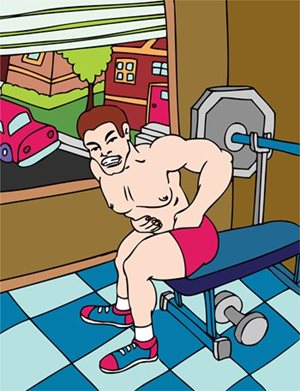 Overview
Overview
A sports hernia is a painful groin injury. The medical community uses the term “athletic pubalgia” to distinguish sport hernias from traditional hernias. A traditional hernia refers to defects or holes in the abdominal wall through which other tissues can push through (herniate). A sports hernia refers to strains or injuries to the soft tissues of the groin or lower abdomen that can occur when an athlete makes a sudden change in direction. Although it is possible for a sports hernia to eventually lead to a traditional hernia, this is not common.
Description
Sports hernias occur when the soft tissues (muscles, tendons, or ligaments) of the groin or lower abdomen are suddenly forcefully stretched, such as during a twist or a kick. Tendons are the strong bands of tissue that connect muscles to bones, whereas ligaments are the bands that connect bones directly to other bones. The most commonly injured tissues in sports hernias are the abdominal oblique muscles, or, more specifically, the tendons that attach these muscles to the pubic bone. The adductor muscles, which connect the pelvis to the thigh and help pull the legs together, may also be injured.
Injuries occur when a muscle is actively contracting while being pulled in the opposite direction. This can happen if the foot is planted and the athlete suddenly twists while the abdominal or groin muscles are actively working.
Sports hernias are frequently seen in sports that require sudden explosive changes in directions such as soccer, hockey, football, and wrestling.
Sports hernias usually result in severe groin pain at the time of injury. Later, the athlete may experience soreness or stiffness with activities such as getting out of bed or a car. Any activity that increases abdominal pressure, such as coughing or sneezing, may also increase pain.
Doctor Examination
First, your doctor will ask questions about how the injury occurred and what activities still cause pain or symptoms. Next, your doctor will perform a physical exam. He or she will likely find a tender area in the groin or pelvic bone in the pubic area. The exam will be easier if you wear loose shorts. Your doctor may also try to replicate symptoms by having you squeeze your thighs together against resistance or do a sit up.
After the physical exam, your doctor will likely order an X-ray or MRI (magnetic resonance imaging).
Nonsurgical treatment
Initially, for the first 1-2 weeks, rest is the best treatment. It is important to avoid repeat stress to the injured area. Ice and non-steroidal anti-inflammatory medicines (ibuprofen or naproxen) can help control swelling and pain. Compression shorts or wraps may also provide comfort.
After 2 weeks, physical therapy and home exercises are usually recommended to improve flexibility and strength.
After 4-6 weeks, you may be allowed to return to sports if the pain has resolved. If pain persists, your doctor may recommend a steroid injection or possibly even surgery.
Surgical treatment
Surgery may be done to repair or reattach the torn tissue in the groin, however this is usually only recommended if non-operative treatment fails. If pain is severe, your doctor may suggest cutting the small inguinal nerve in the groin (inguinal neurectomy) to decrease sensation in this area. If tightness is a problem, your surgeon may offer a surgery that lengthens the tendon connecting your inner thigh muscles to your pelvis (adductor tenotomy). Because every patient is different, your doctor will discuss the surgical options that best meet your needs.
Outcomes
Most sports hernias can heal with rest and surgery can usually be avoided. In persistent or recurrent cases, surgery may be recommend to repair damaged tissue. Most athletes will be able to return to full activity.
More Information
Page QR Code:

Q: Why do sports hernias occur?
Abdominal and groin muscles attach to the pelvis. Such muscles are very strong. If these muscles contract while the body suddenly twists in the opposite direction, they can tear at their insertion points (tendons) and cause severe pain.
Q: Are sports hernias different than other hernias?
Yes. Sports hernias are tears or injuries of the soft tissues attaching to the pelvic (pubic) bones – similar to sprains or strains. True hernias are holes or defects in tissue. True abdominal hernias allow tissue such as fat, muscle, or even intestines to bulge through. Sports hernias occur due to rapid firing of muscles during a sudden twisting motion. To avoid confusion, many prefer the term athletic pubalgia rather than sports hernia.
Q: What are the signs of a sports hernia?
Sports hernias usually occur during a sudden twist during an athletic event such as soccer, football, hockey, or wrestling. Pain is usually immediate and severe and localized to the groin. Later, soreness and stiffness may persist, making activity such as getting out of bed or a car difficult. Some may feel groin pain during activities that increase intra-abdominal pressure, such as sneezing and coughing.
Q: Are X-rays useful to diagnose a sports hernia?
Since sports hernias are injuries to soft tissues, X-rays will not show the actual injury. X-rays are, however, usually recommended to rule out other causes of the pain, such as when a small piece of bone pulls off of the hip/pelvis (this is more common in children and adolescents than in adults). If X-rays do not show anything, magnetic resonance imaging (MRI) may be recommended.
Q: Do sports hernias require surgical repair?
Usually, No. Since most sports hernias can heal with rest, surgery can usually be avoided. In persistent or recurrent cases, surgery may be recommend to repair damaged tissue.
Questions to ask your doctor:
- When is it safe to return to play?
- Are there activities that increase the risk of sports hernia?
- How does a sports hernia differ from other hernias?

 POSNA.org
POSNA.org
 Overview
Overview